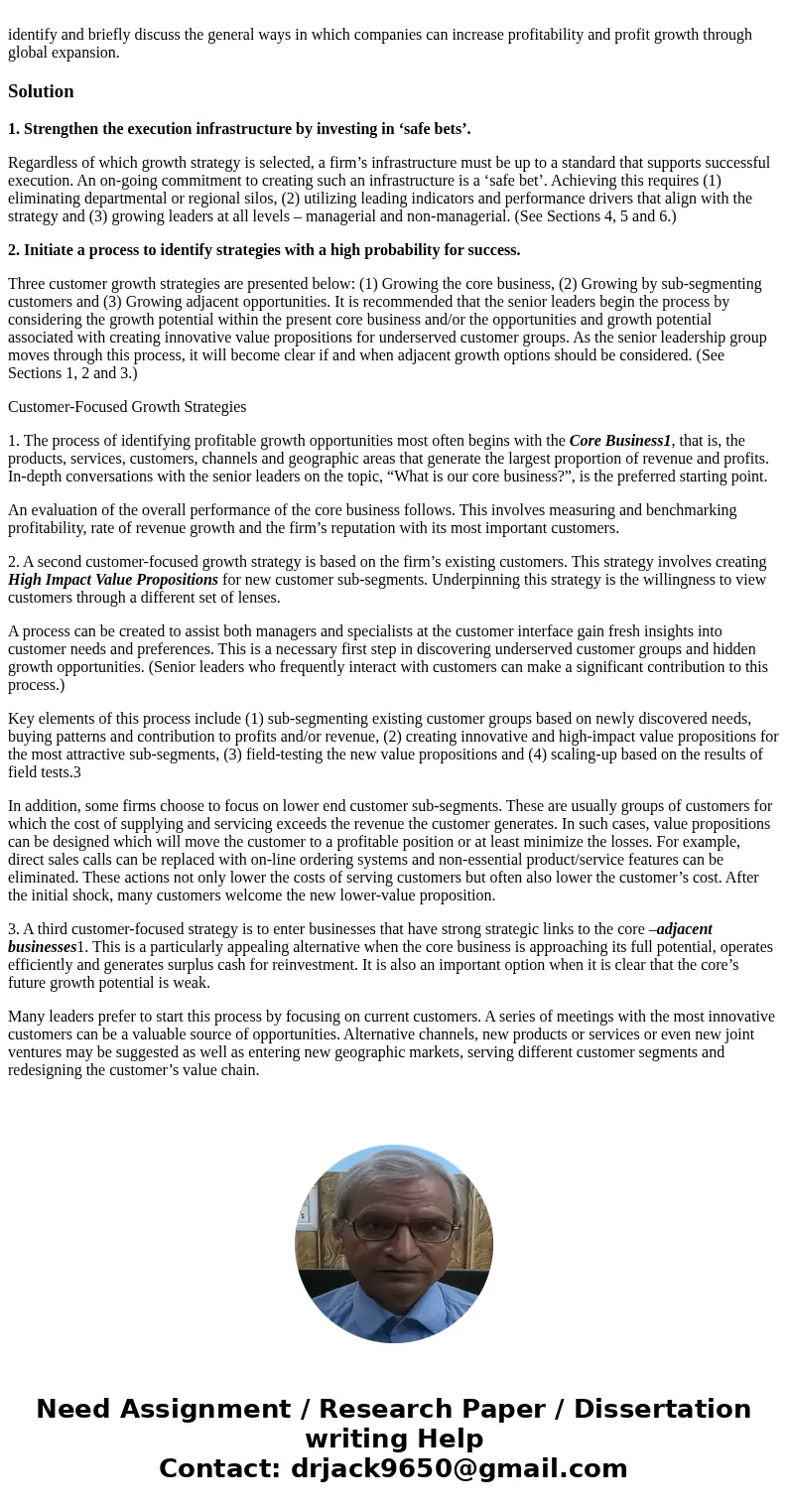identify and briefly discuss the general ways in which compa
identify and briefly discuss the general ways in which companies can increase profitability and profit growth through global expansion.
Solution
1. Strengthen the execution infrastructure by investing in ‘safe bets’.
Regardless of which growth strategy is selected, a firm’s infrastructure must be up to a standard that supports successful execution. An on-going commitment to creating such an infrastructure is a ‘safe bet’. Achieving this requires (1) eliminating departmental or regional silos, (2) utilizing leading indicators and performance drivers that align with the strategy and (3) growing leaders at all levels – managerial and non-managerial. (See Sections 4, 5 and 6.)
2. Initiate a process to identify strategies with a high probability for success.
Three customer growth strategies are presented below: (1) Growing the core business, (2) Growing by sub-segmenting customers and (3) Growing adjacent opportunities. It is recommended that the senior leaders begin the process by considering the growth potential within the present core business and/or the opportunities and growth potential associated with creating innovative value propositions for underserved customer groups. As the senior leadership group moves through this process, it will become clear if and when adjacent growth options should be considered. (See Sections 1, 2 and 3.)
Customer-Focused Growth Strategies
1. The process of identifying profitable growth opportunities most often begins with the Core Business1, that is, the products, services, customers, channels and geographic areas that generate the largest proportion of revenue and profits. In-depth conversations with the senior leaders on the topic, “What is our core business?”, is the preferred starting point.
An evaluation of the overall performance of the core business follows. This involves measuring and benchmarking profitability, rate of revenue growth and the firm’s reputation with its most important customers.
2. A second customer-focused growth strategy is based on the firm’s existing customers. This strategy involves creating High Impact Value Propositions for new customer sub-segments. Underpinning this strategy is the willingness to view customers through a different set of lenses.
A process can be created to assist both managers and specialists at the customer interface gain fresh insights into customer needs and preferences. This is a necessary first step in discovering underserved customer groups and hidden growth opportunities. (Senior leaders who frequently interact with customers can make a significant contribution to this process.)
Key elements of this process include (1) sub-segmenting existing customer groups based on newly discovered needs, buying patterns and contribution to profits and/or revenue, (2) creating innovative and high-impact value propositions for the most attractive sub-segments, (3) field-testing the new value propositions and (4) scaling-up based on the results of field tests.3
In addition, some firms choose to focus on lower end customer sub-segments. These are usually groups of customers for which the cost of supplying and servicing exceeds the revenue the customer generates. In such cases, value propositions can be designed which will move the customer to a profitable position or at least minimize the losses. For example, direct sales calls can be replaced with on-line ordering systems and non-essential product/service features can be eliminated. These actions not only lower the costs of serving customers but often also lower the customer’s cost. After the initial shock, many customers welcome the new lower-value proposition.
3. A third customer-focused strategy is to enter businesses that have strong strategic links to the core –adjacent businesses1. This is a particularly appealing alternative when the core business is approaching its full potential, operates efficiently and generates surplus cash for reinvestment. It is also an important option when it is clear that the core’s future growth potential is weak.
Many leaders prefer to start this process by focusing on current customers. A series of meetings with the most innovative customers can be a valuable source of opportunities. Alternative channels, new products or services or even new joint ventures may be suggested as well as entering new geographic markets, serving different customer segments and redesigning the customer’s value chain.

 Homework Sourse
Homework Sourse